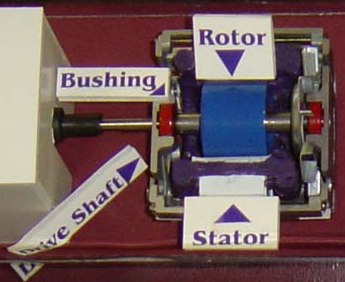Creation Science Museum of Canada
Virtual Museum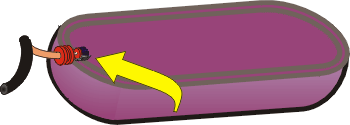 This is like you being able to spin you head around, and around, and around! So how does it do it? Scientists are pushing the limits of modern technology to be able to dissect these bacteria to see just how on earth they spin their tails. It turns out that the bacteria has something that is just like an electric motor built inside of it!
This is like you being able to spin you head around, and around, and around! So how does it do it? Scientists are pushing the limits of modern technology to be able to dissect these bacteria to see just how on earth they spin their tails. It turns out that the bacteria has something that is just like an electric motor built inside of it! 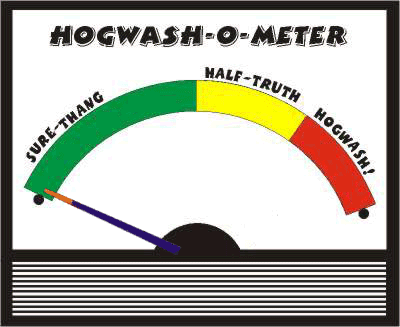 Now, ask yourself a question: Do you think that motor could have been formed by natural processes? Maybe some molten lava flowed down a mountain side into some water, which formed the rotor in just the right shape and size, and right at the same time, wrapped around it was some molten lava that rolled down the mountain side and was also quickly cooled landing in the water. Perhaps some other lava got mixed in there which was copper – just the right metal to make the wires which happened to get interwoven through, in, and around the stator just right. The bushing was exactly the right size around the drive shaft which just happened to be attached to the dead center of the rotor…… Okay, you get the point. It’s ridiculous to suggest! If any part of that motor is incomplete, or not doing its job exactly the way it was designed to, the whole motor breaks down and doesn’t work! When we take a look inside the bacterial flagellum, we see a stator (the C ring, held in place by the STUDS), a rotor (the M & S rings), the drive shaft (the ROD), the bushing or bearing (the L & P rings), it even has what many have called the “universal joint”, the hook – which is what changes the direction of the rotational force.
Now, ask yourself a question: Do you think that motor could have been formed by natural processes? Maybe some molten lava flowed down a mountain side into some water, which formed the rotor in just the right shape and size, and right at the same time, wrapped around it was some molten lava that rolled down the mountain side and was also quickly cooled landing in the water. Perhaps some other lava got mixed in there which was copper – just the right metal to make the wires which happened to get interwoven through, in, and around the stator just right. The bushing was exactly the right size around the drive shaft which just happened to be attached to the dead center of the rotor…… Okay, you get the point. It’s ridiculous to suggest! If any part of that motor is incomplete, or not doing its job exactly the way it was designed to, the whole motor breaks down and doesn’t work! When we take a look inside the bacterial flagellum, we see a stator (the C ring, held in place by the STUDS), a rotor (the M & S rings), the drive shaft (the ROD), the bushing or bearing (the L & P rings), it even has what many have called the “universal joint”, the hook – which is what changes the direction of the rotational force.
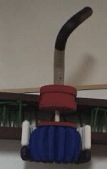
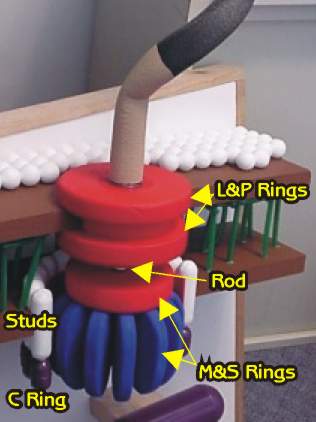 But what of the bacterial motor? It is no different than the electric motor! How could it have evolved? If any one of those parts isn’t quite evolved, the whole system breaks down, our bacteria can’t get around and it dies! If any one of those parts suffers a change in its attempt to “evolve”, it no longer does its original job, the whole motor fails, the bacteria dies!
But what of the bacterial motor? It is no different than the electric motor! How could it have evolved? If any one of those parts isn’t quite evolved, the whole system breaks down, our bacteria can’t get around and it dies! If any one of those parts suffers a change in its attempt to “evolve”, it no longer does its original job, the whole motor fails, the bacteria dies!
In modern times we think something is a superior technology if it’s smaller, faster, more energy efficient. Well, this motor is so small 8,000,000 of them can fit on the tip of one of your hairs! An electric motor cannot reproduce, or find its own energy, or repair itself! The bacteria can do all of these.
Where there is design, there is a designer.
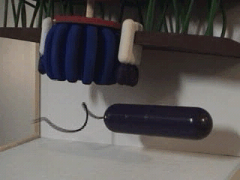
 Many types of bacteria swim through water by spinning a rubber-like “tail” called a flagellum. Because it’s rubber-like and because the semi-solid “hook” holds it at an angle, the flagellum takes on a corkscrew shape, acting like a propeller in the water.
Many types of bacteria swim through water by spinning a rubber-like “tail” called a flagellum. Because it’s rubber-like and because the semi-solid “hook” holds it at an angle, the flagellum takes on a corkscrew shape, acting like a propeller in the water.